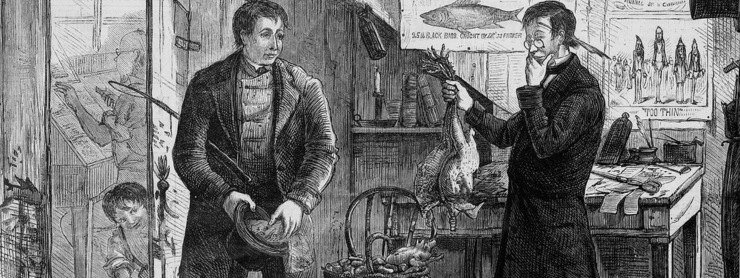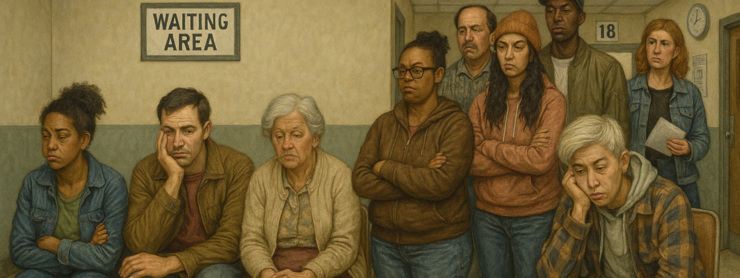The past never truly stays where it belongs. Even when the truth is carefully scrubbed from our understanding of history, its spores disperse through time to seep into the firmament like a persistent black mold poisoning the air we breathe. We are familiar with its effects, but none the wiser as to its causes. It is in the assumptions of media figures and pundits as to which policies are “practical” and which candidates are “electable.” It is in all of the trite and shallow excuse-making by the powerful as to why better things aren’t possible, and why straightforward solutions to basic problems of governance are out of the question. It is in the refusal of elected progressives to use the very tools of power and leverage that their corporatist and right-wing rivals wield with impunity. It is in the insistence that making demands is impertinent, and that the solution is to continue doing the things that didn’t work before, but with more feeling. Be civil, be congenial, play by the rules, vote harder. These patterns are not new; they were old when Ralph Nader complained of them in the 1960s. They are not mere accidents of fate, nor are they some natural evolutionary outcome of rigorous public debate and discourse. As with all social constructs, the heavy hand of intention is evident for those who know where to look for it. There is a story of how it got there, and that story’s erasure from the public discourse is a critical part of it. The true details were omitted from accounts of our history to promote a false consciousness among the public as to what this country is and how it got to be this way.
While the full story may never be entirely uncovered, we now have access to enough of it to establish the pattern thanks to the resourceful original research conducted by University of Iowa history professor Landon Storrs in her book The Second Red Scare and the Unmaking of the New Deal Left. Storrs profiles dozens of cases of the best and the brightest young professionals who responded to the call to public service in the darkest hours of the Great Depression. These people were non-communist leftists who reflected the popular consensus of the time that unfettered capitalism and “free enterprise” had led the world to the brink of ruination, and that the future would necessarily include some form of democratic socialism. They understood that, as FDR framed it in his 1944 State of the Union address, “necessitous men are not free men,” and that true democracy required economic security for all. These were the architects of the greatest of the New Deal programs that saved the country from economic collapse in the 30s, achieved unthinkable levels of productivity during World War II, instituted modern labor laws, and brought underdeveloped portions of the country into the modern world. These heroes and heroines were rewarded for their service with a 20th century version of the Spanish Inquisition, a cynically manufactured pretext weaponized by the right-wing forces of the existing capital order to thwart economic democracy and purge the very idea from the public consciousness. Many were hounded out of government and pursued in private life by federal agents who sabotaged their employment prospects using the stigma of the allegations. Still others survived the purges by abandoning their visionary policy agendas and social priorities, forced instead to live a lie. The work of people like Isidore Falk on national single payer healthcare, Arthur “Tex” Goldschmidt on public power utilities, and Catherine Bauer Wurster on Austrian style public housing was derailed and purged from the discourse by toxic associations with “subversive” tendencies. Many others were persecuted for their work on the right’s most hated policies including Social Security, consumer rights, labor rights, minimum wage, and the Marshall Plan in post-war Europe. Their legacy, and that of their oppressors, echoes through time to the present day like an invisible assassin of hope and possibility.
In a period dominated by the circus-like antics of Martin Dies’s House Un-American Activities Committee, which had a travelling roadshow and numerous state-level spinoffs, it is easy for the far less public Federal Employee Loyalty Boards to slip under the narrative radar. These secretive closed-door proceedings were more action-oriented and less performative than the better-known red scare institutions of the period. Storrs describes a heavy-handed process that, once begun, never truly ended. There were no due process rights or protections against double jeopardy; a closed case could be reopened at any time and for any reason. Rumor and innuendo were sufficient; there were neither rules of evidence nor a right to face one’s accuser. As a condition of employment, subjects were required to submit to exhaustive investigations of their personal lives by investigators who had little training and an excess of zeal in the hunt for subversive tendencies and “thought crimes.” Short of the dreaded “full field investigation” by J. Edgar Hoover’s FBI, they could be forced to submit extensive written answers to “interrogatories” at any time and for any reason. They could expect to be interrogated as to friendships, affiliations, and social interactions going back decades, as well as those of their spouses and other relatives. Even the defense attorneys retained by these civil servants faced ostracism and intimidation. These incredibly invasive procedures were weaponized by the right-wing coalition behind the established order to de-rail the New Deal agenda and to punish its champions.
The stakes were high, and the consequences of failing a Federal Employee Loyalty Board investigation were dire. A federal employee did not merely face dismissal from their job and a ban on government employment. They also faced a broader unofficial employment blacklist, a social and economic ostracism that would follow them wherever they went. With that in mind, the attorneys for these civil servants advised them to burnish and exaggerate their anti-communist bona fides. They urged them to denounce and distance themselves from friends and family members who were seen as liabilities, whether they had affiliations with the Communist Party or merely causes that could be labeled as “subversive” or “communistic.” Their legal counsel advised them to construct a false identity and repudiate many of their core beliefs. Because of the never-ending nature of these loyalty proceedings, any perceived inconsistency could trigger a renewed cycle of career jeopardy and harassment. These defendants thus were forced to live the lie of those false identities, and to abandon their ambitious and visionary agendas. They were forced to either reinvent themselves as fiercely anti-communist cold war liberals, or to leave the government and policy arena entirely.
In an era when the mere accusation of disloyalty could ruin lives, those who survived this inquisitorial gauntlet took great pains to hide their trauma and keep their past a secret. They acquired reputations as forceful reactionaries who repudiated those of younger generations who strayed too far to the left in their politics. In many of the cases examined by Storrs, the defendants’ own children were unaware of what happened to them until after their deaths. Between the trauma-conditioned desperation of loyalty defendants to keep their secrets, and the destruction of many of the records on the government end, Storrs was forced to engage in an odyssey of creative detective work to uncover the details of the cases discussed in the book. As a credentialed academic historian, Storrs acknowledges that she cannot prove the Loyalty Board persecutions were the reason for these drastic political transformations, but readers are free to use their intuition and draw the obvious conclusion. The real problem, as Storrs points out, is that neither their contemporaries nor the historians who chronicled the life and times of these people are aware that this happened at all. The terror of these survivors became quietly institutionalized. It became part of the political culture of the Beltway, instilled in subsequent generations of civil servants and elected officials with no explanations as to why. Soon enough, people stopped asking and started assuming. Thus, this new consensus became “just the way it is,” with no acknowledgement of the way it was before these dystopian inquisitorial purges took place.
Antonio Gramsci, in the notebooks he penned from a prison cell in Mussolini’s fascist Italy, refers to this consensus as the “common sense.” He describes it as working in service of “cultural hegemony,” the process by which the consensus view of the powerful becomes accepted as the inevitable status quo, or “just the way it is.” With the use of this draconian process, in tandem with many other persecutorial institutions of the period, the power elite in the US reasserted their hegemony by purging the old common sense and replacing it with a new one. They secured its acceptance as cultural norm by suppressing knowledge of how it got there, and by silencing discussion of what came before until it was largely forgotten.
Modern progressives periodically rediscover the old writings of these legends of the New Deal era, with no knowledge of what happened to them. They engage in a naïve kind of solutionism, believing that if they just adopt this forgotten bit of wisdom from the past, the current system will work the way it was always meant to. They fail to realize that the system is working the way it was meant to; that the fate of those Institutionalists like Leon and Mary Keyserling, Katherine Bauer Wurster, Tex Goldschmidt, Elizabeth Wickenden and many others who espoused those views was persecution and repudiation. Missing from their understanding is the knowledge of the kind of brutal countermeasures that the powerful can mobilize should advocates of such policies get too close to success.
Generations of politicians, pundits, and regular people raised in the milieu of this new cultural hegemony regurgitate the inane assumptions of this ossified “common sense” from every major media platform like a catechism or statement of religious faith. In a recent interview, former MSNBC host Chris Matthews recited the pedestrian understandings of his time, things “everyone knows” that just aren’t so. Particularly illustrative is his discussion of the 1972 candidacy of George McGovern as proof that the Democratic Party will suffer ignominious defeat if they go “too far left.” This conventional wisdom, so ubiquitous amongst Matthews’s generation, is ridiculous on its face. McGovern was a milquetoast moderate with a pragmatic stance against the war in Vietnam. His crime was to win the nomination with grassroots support against DNC favorites like Edmund Muskie. Deriving Matthews’s conclusion requires ignoring the degree of treachery from within the establishment of the DNC leadership, many of whom openly campaigned for Republican Richard Nixon. The terror of “drifting too far to the left,” a product of this cultural hegemony, is conditioned into his generational cohort to the degree that he readily accepts this flimsy narrative without evidence and without question. In doing so he misses the real lesson of the 1972 campaign: the savagery with which the forces of the power elite will respond to perceived threats to their cultural hegemony.
In his ignorance, Matthews became an agent of that agenda. Like many others in the so-called “liberal” media space, he was determined to police the left boundaries of acceptable discourse with no insight into why. In his career ending move, his comically exaggerated alarm at seeing those boundaries breached led him to compare the Sanders primary win in Nevada to Germany’s invasion of France in 1940, on the heels of his ludicrous speculation that a Sanders victory would lead to guillotine executions in Central Park. In that irrational panic we see echoes of Leon Keyserling and thousands of other victims of the Federal Employee Loyalty Boards, whose learned phobia associated with that perceived red line was institutionalized while its origins were hushed up. That fear and the new common sense built around it are the legacy of the second red scare.
The lessons of this history and its ripple effects through time reveal broader truths. The boundaries of establishment consensus discourse and what Gramsci calls the “common sense” were not handed down from the heavens etched on stone tablets. They were put there by people, usually in service of an elite agenda to defend and maintain the arrangements that suit them. The things we assume without question can obscure important truths with the potential to alter everything we think we know. They can also be used to manipulate people who perceive some benefit from the status quo arrangement into acting as agents of its perpetuation. Awareness of what they are doing is not necessary or even particularly common. The distinction makes little difference in practice. Lawmakers are responding to institutional imperatives that have far more power over their policy decisions than majority opinion or democracy. This is maintained by the soft power of elite cultural hegemony, which is reinforced every time a pundit or politician gaslights the public about what’s practical, possible, or realistic. Less often explicitly articulated is a conditioned existential dread of the ill-defined consequences of challenging these norms from the left, and only from the left. Whether it is cynical dissembling or is legitimately believed, this primal fear is the justification for progressive lawmakers’ refusal to wield the same tools of power their right-wing counterparts exercise so freely. By failing to interrogate the legitimacy of those boundaries and how they got there in the first place, they help to perpetuate the scam of “pragmatism” and the demoralization of their base. As psychologist Stephanie Preston pointed out in a recent Macro N Cheese episode, those who seek to manipulate public opinion understand one thing very well: without access to contravening facts, people can be induced to accept all manner of transparently false assumptions that benefit the existing order.
History teaches us that there is nothing inevitable about “the way it is,” and there is nothing “pragmatic” about accepting the inevitability of the status quo. Like any social construct, it was put there by interested parties and could be taken down. Questioning the legitimacy of such assumptions and how they got there is a fine place to start. But the more important inquiry is cui bono – who benefits from this arrangement. When the façade finally falls, we can expect those beneficiaries to be waiting on the other side with knives out. Like those who came before them, the heirs of the legacy of the red scare are not known for accepting defeat with equanimity. Breaking free of false consciousness is the beginning of the fight for a better future, not the end.





